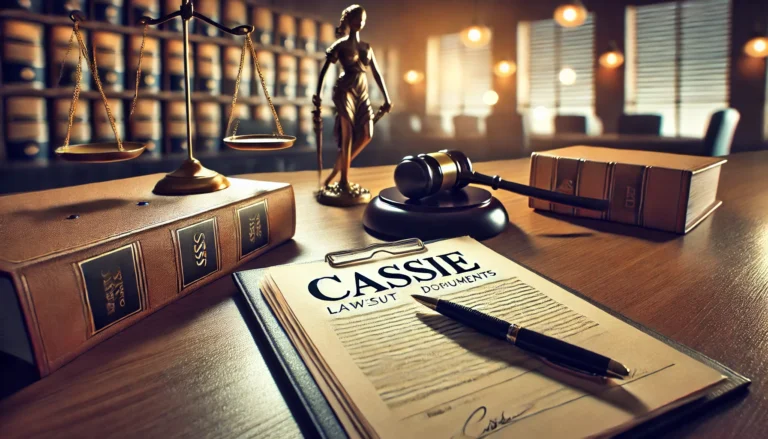The Cassie lawsuit documents represent a critical collection of legal files and evidence related to the ongoing litigation involving Cassie. These documents are pivotal in understanding the case’s complexities and the arguments presented by both sides. They serve as the foundation for the legal proceedings and provide insight into the claims and defenses being asserted.
Understanding these documents is essential for anyone interested in the case, including legal professionals, media, and the general public. They reveal the details surrounding the lawsuit and the implications for the parties involved.
The significance of the Cassie lawsuit documents extends beyond the case itself, as they may set precedents for future legal matters. Analyzing these documents helps illuminate the broader issues at play within the legal system.
Background of the Cassie Lawsuit
The Cassie lawsuit stems from a series of events that have raised substantial legal questions and concerns. It involves allegations that require thorough investigation and legal examination. The case has garnered media attention, highlighting the potential implications for those involved and the broader community.
Key factors that led to the lawsuit include personal grievances, contractual disputes, or issues of public concern. As the case unfolded, it became apparent that various stakeholders were impacted, leading to a complex legal battle.
Understanding the background provides context for the allegations and the significance of the documents associated with the case. It allows individuals to grasp the motivations behind the lawsuit and its potential repercussions.
Key Allegations in the Cassie Lawsuit
The key allegations in the Cassie lawsuit form the core of the legal arguments presented. These allegations are crucial in framing the narrative of the case and determining the legal outcomes for the parties involved.
Some of the primary allegations include:
- Breach of Contract: Claims that one party failed to uphold their contractual obligations, leading to damages for the other party.
- Negligence: Allegations that actions or inactions by one party resulted in harm or loss to another.
- Fraud: Claims that deceptive practices were employed, misleading one party to their detriment.
These allegations will be supported by evidence found within the Cassie lawsuit documents. Understanding the specifics of these claims is essential for evaluating the strength of the case.
Overview of Cassie Lawsuit Documents and Their Importance
Cassie lawsuit documents are a compilation of various legal papers that are essential to the proceedings. They include pleadings, motions, exhibits, and other relevant materials that outline the arguments, evidence, and legal strategies of both parties.
Types of Documents:
| Document Type | Description |
| Complaint | The initial filing that outlines the plaintiff’s allegations. |
| Answer | The defendant’s response to the allegations made in the complaint. |
| Motions | Requests for the court to make specific rulings or orders. |
| Exhibits | Supporting evidence presented to substantiate claims or defenses. |
The importance of these documents cannot be overstated. They not only guide the legal process but also provide transparency and accountability within the judicial system. Access to these documents allows stakeholders to follow the case’s progress and understand the arguments being made.
Types of Documents Involved in the Cassie Lawsuit
The types of documents involved in the Cassie lawsuit play a significant role in shaping the legal proceedings. Each document serves a specific purpose and contributes to the overall understanding of the case.
Some common types of documents include:
- Filing Documents: These include the initial complaint and subsequent filings that outline the legal arguments.
- Discovery Materials: Documents exchanged between parties to gather evidence, such as interrogatories, depositions, and requests for documents.
- Court Orders: Official rulings made by the judge that direct the actions of the parties involved.
These documents collectively provide a comprehensive view of the case, detailing the interactions between the parties and the evidence being presented.
How to Access Cassie Lawsuit Documents
Accessing the Cassie lawsuit documents can be important for those interested in following the case. These documents are typically available through several avenues, depending on the jurisdiction and the court handling the case.
Options for accessing these documents include:
- Court Websites: Many courts maintain online databases where public records, including lawsuit documents, can be searched and accessed.
- Legal Databases: Subscription-based legal research platforms, such as Westlaw or LexisNexis, provide access to court documents and case law.
- In-Person Requests: Interested individuals can visit the courthouse and request copies of the documents directly from the clerk’s office.
Understanding how to access these documents allows stakeholders to stay informed and engage with the ongoing legal proceedings effectively.
The Role of Cassie Lawsuit Documents in the Legal Process
Cassie lawsuit documents play a critical role in the legal process, serving as the backbone of the case. They provide the necessary documentation to support claims and defenses, helping to guide the court’s decisions.
These documents are essential for:
- Establishing Evidence: The documents present the facts and evidence required to support the allegations made by both parties.
- Facilitating Communication: They ensure that all parties are informed about the proceedings and arguments being made.
- Influencing Court Decisions: Judges rely on the information contained in these documents to make informed rulings throughout the case.
By understanding the significance of these documents, individuals can appreciate their impact on the judicial process.
Analyzing the Implications of Cassie Lawsuit Documents
The implications of the Cassie lawsuit documents extend beyond the immediate case. Analyzing these documents can reveal trends and issues that may affect similar cases in the future.
Key implications include:
- Precedent Setting: The case may establish legal precedents that influence future lawsuits involving similar allegations.
- Policy Changes: Depending on the outcome, the case may prompt organizations to reevaluate and improve their policies and practices.
- Public Awareness: The lawsuit can raise awareness about specific issues within the community, encouraging discussions and potential reforms.
These implications underscore the importance of following the developments of the case and understanding the broader context of the lawsuit.
Legal Proceedings Related to the Cassie Lawsuit
The legal proceedings related to the Cassie lawsuit involve a series of steps that follow the initial filing of the complaint. Understanding these proceedings is essential for grasping the timeline and the legal landscape of the case.
The typical sequence of legal proceedings includes:
- Filing the Complaint: Initiating the lawsuit by formally outlining the allegations against the defendant.
- Response from the Defendant: The defendant files an answer to the complaint, addressing the allegations made against them.
- Discovery Phase: Both parties exchange relevant documents and evidence to build their respective cases.
- Pre-Trial Motions: Lawyers may file motions to resolve specific issues before trial, potentially shaping the arguments presented.
- Trial: If the case proceeds to trial, both sides present their arguments, evidence, and witnesses before a judge or jury.
This structured legal process ensures that each party has the opportunity to present their case while adhering to established legal protocols.
Reactions to the Cadets Drum Corps Lawsuit from the Community
The Cadets Drum Corps lawsuit has elicited various reactions from the community, including alumni, current members, and supporters. Many individuals are closely monitoring the developments and are eager to understand the potential impact on the organization.
Supporters of the Cadets express concern about the allegations and the potential damage to the organization’s reputation. They often emphasize the positive experiences they had while participating and hope for a resolution that ensures the safety and well-being of all members.
Conversely, those who have voiced their concerns recognize the importance of addressing allegations of misconduct. Community discussions often focus on the need for reform within youth organizations to prevent similar situations in the future.
Future Developments in the Cassie Lawsuit
As the Cassie lawsuit progresses, several future developments are anticipated. Monitoring these developments is crucial for understanding the potential outcomes and their implications.
Potential future developments may include:
- Mediation or Settlement Discussions: The parties may seek to resolve the case through mediation or settlement negotiations, avoiding a lengthy trial.
- Trial Dates: If the case proceeds to trial, setting dates for the trial will become a focus as both sides prepare their arguments.
- Community Engagement: Increased community involvement and dialogue may emerge, encouraging broader conversations about youth safety and organizational practices.
Staying informed about these developments allows stakeholders to engage with the case meaningfully and advocate for necessary changes.
Conclusion: The Significance of Cassie Lawsuit Documents in Understanding the Case
In conclusion, the Cassie lawsuit documents are essential for understanding the intricacies of the case and its implications for the parties involved. They provide crucial insights into the allegations, the legal arguments, and the overall context surrounding the lawsuit.
The importance of these documents extends beyond the immediate case, influencing future legal matters and prompting discussions about accountability within youth organizations. By engaging with these documents, stakeholders can better grasp the complexities of the situation.
Overall, the ongoing developments surrounding the Cassie lawsuit highlight the necessity for transparency, ethical practices, and accountability within organizations serving youth.
Final Thoughts on Cassie Lawsuit Documents
In summary, the Cassie lawsuit documents serve as a pivotal element in the ongoing legal proceedings. They provide vital information that can shape the future of the organization and its members.
As the case unfolds, it is crucial for all stakeholders to remain informed and advocate for positive changes. The commitment to learning from this experience can lead to a better understanding of the issues at hand and foster a safer environment for youth organizations moving forward.
Frequently Asked Questions (FAQs)
What are Cassie lawsuit documents?
Cassie lawsuit documents refer to the legal filings, evidence, and other relevant paperwork associated with the ongoing lawsuit involving Cassie. These documents include complaints, answers, motions, and exhibits.
Why are Cassie lawsuit documents important?
These documents are crucial as they provide insight into the allegations, the legal arguments from both sides, and the overall context of the case. They help stakeholders understand the issues at play.
How can I access Cassie lawsuit documents?
Cassie lawsuit documents can typically be accessed through court websites, legal databases, or by visiting the courthouse where the case is being heard. Some documents may also be available through public records requests.
What types of documents are included in the Cassie lawsuit?
Common types of documents in the Cassie lawsuit include the initial complaint, responses from the defendants, discovery materials, motions filed by attorneys, and any court orders issued during the proceedings.
Who filed the Cassie lawsuit, and what are the main allegations?
The Cassie lawsuit was filed by [plaintiffs’ names or “former members” if applicable] against [defendant’s name or “the organization”]. The main allegations include claims of misconduct and improper treatment of participants.
How do Cassie lawsuit documents influence the legal process?
These documents play a critical role in shaping the legal proceedings by providing evidence, outlining claims and defenses, and helping the court make informed decisions regarding motions and trial outcomes.
What can be learned from reviewing the Cassie lawsuit documents?
Reviewing these documents can provide valuable insights into the legal strategies employed by both parties, the challenges faced during the litigation, and the potential implications for similar cases in the future.




